Just another day at the office:
The wildfire broke out about 2 a.m. on June 10 near Getty Center Drive, and according to the L.A. Fire Department: “There are 175 LAFD personnel assigned, battling by ground and air (4 LAFD helicopters), an estimated 30 acres of burning grass and brush in an old burn scar upon a west facing slope of the Sepulveda Pass, entirely on the east side of the San Diego (I-405) Freeway. The heel of the fire is on Sepulveda Boulevard at Getty Center Drive, with the fire’s flanks emanating to the north and south from there. The weather conditions are currently hot and dry with minimal wind. There have been no injuries. No structures are imminently threatened and there are presently no evacuation orders. The blaze, known as the ‘Sepulveda Fire’, has a potential size of 40+ acres.”
Among those assigned were members of Fire Station Engine 69, located on Sunset at Carey in Pacific Palisades.
Every year an outstanding resident (or sometimes a married couple) is chosen as the Fourth of July parade marshal in the Palisades. Although there won’t be a parade this year, the Palisades Americanism Parade Association (PAPA) has still named a marshal — actually, 53 of them will share the honor.
This year’s honorees include individuals who have fought numerous local and state fires, including those recently set by rioters; who help at the scene of traffic accidents; who work with FEMA; who rescue hikers from local mountain trails; and who respond whenever there’s an emergency, such as when an unconscious homeless individual is discovered.
Their professionalism, steeped in compassion, made it an easy choice for PAPA this year to name Fire Stations 69 and 23 (on Sunset at Los Liones) as this year’s parade marshals.
Since these individuals are generally on call and serving during the parade, this is the perfect year to honor them – virtually, of course!
FIRE STATION 23
Currently three captains serve the station.
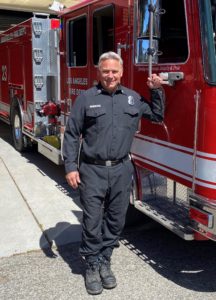 SCOTT GRIBBONS (A-shift) has been a member of LAFD for 33 years and a captain for 22. He has worked in South Los Angeles, the San Fernando Valley, mid-city and downtown. Gribbons first came to the Palisades a year before Engine 69 was closed because of budget cuts during 2011. (It was one of 18 engines cut in the City). “I circled back to FS 23 about four years ago, recognizing there is no better place to work than right here in this community,” he said.
SCOTT GRIBBONS (A-shift) has been a member of LAFD for 33 years and a captain for 22. He has worked in South Los Angeles, the San Fernando Valley, mid-city and downtown. Gribbons first came to the Palisades a year before Engine 69 was closed because of budget cuts during 2011. (It was one of 18 engines cut in the City). “I circled back to FS 23 about four years ago, recognizing there is no better place to work than right here in this community,” he said.
“The Palisades community is like no other and we are thankful for the incredible support and relationships that have been developed here over many generations,” said Gribbons, who has served as the board chair for the Firefighters First Credit Union and also worked with the Fire Family Foundation. “I have the opportunity to help firefighters in need as the result of work-related injuries, family illness and a host of other situations that many of us experience over our lifetimes.”
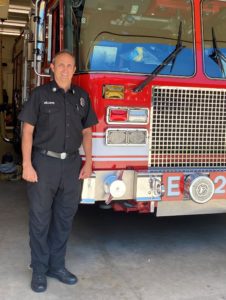 ROBERT WILLIAMS (B-shift), a member of LAFD since 1987, started working in the Palisades in 2017. “The friendliness of the members of the community is always a breath of fresh air and nice to be a part of,” Williams told CTN in an interview at the station.
ROBERT WILLIAMS (B-shift), a member of LAFD since 1987, started working in the Palisades in 2017. “The friendliness of the members of the community is always a breath of fresh air and nice to be a part of,” Williams told CTN in an interview at the station.
He has one friendly reminder for the community about brush clearance. “I think it’s everyone’s responsibility to take brush and vegetation clearance to heart,” he said. “We have had the Skirball, Palisades and Getty fires in recent years, which have left a lasting memory. These are good examples of why we need to stay vigilant with fire protection in our community.”
KURT VOSBERG (C-shift) is the newest addition to FS 23, coming to the Palisadesabout nine months ago.
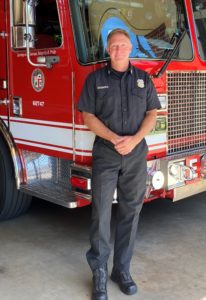 “There is a sense of community here,” he said, and he complimented residents on their adherence to brush clearance and fire safety awareness, such as making sure smoke detectors are up to date. He also warns people against hoarding because if their house catches on fire, “that’s a big problem in trying to fight it.”
“There is a sense of community here,” he said, and he complimented residents on their adherence to brush clearance and fire safety awareness, such as making sure smoke detectors are up to date. He also warns people against hoarding because if their house catches on fire, “that’s a big problem in trying to fight it.”
Vosberg praised the Palisades Task Force on Homelessness, stating “They deal with the people the right way.”
He began his LAFD career in 1988 and has worked downtown, Hollywood and North Hollywood, where he was based during the 1992 riots. He was on duty during the Northridge Earthquake and during the Pan Pacific Park fire in 1989.
Other members of FS 23 are (A Platoon) Robert Appleford, Andre Zimbeck and Darin Herbert; (B Platoon) Josh Burton, Tommy Oberto, Armando Carranza, Bob Williams, Mike Spears and Paul Sorum; and (C Platoon) Jim Nordquist, Jim Rogers, Jeff Foster, Tom Nordquist and Bob Johnson.
FIRE STATION 69
There are two captains for each shift.
A-Shift: Captains Jeff Brown and Darren Kesterson
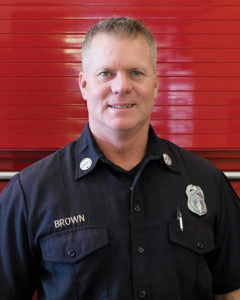 JEFF BROWN came to Station 69 from the North Hollywood Station in 2017 and has served with LAFD for more than 30 years. He currently helps train new recruits.
JEFF BROWN came to Station 69 from the North Hollywood Station in 2017 and has served with LAFD for more than 30 years. He currently helps train new recruits.
He loves working with his colleagues. “They’re all senior guys who are well-trained, educated and top-notch,” Brown said. “There’s a great team that’s been built here.”
Along with serving the LAFD, Brown was also part of FEMA’s Urban Search and Rescue Task Force for 10 years and worked the Los Angeles riots in 1992.
He also helped battle the Thomas Fire in the Santa Barbara area in December 2017. “It looked like the Los Angeles riots,” Brown said. “Everything was burning, and we had to choose to save this house or the one across the street.”
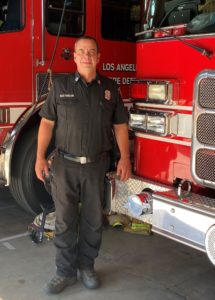 DARREN KESTERSON, the newest captain, spent his first day in Pacific Palisades on June 8 and the next night went with Engine 69 to the brush fire near the Getty Center along the 405 Freeway.
DARREN KESTERSON, the newest captain, spent his first day in Pacific Palisades on June 8 and the next night went with Engine 69 to the brush fire near the Getty Center along the 405 Freeway.
“This is a beautiful area,” said Kesterson, who spent most of his career in South L.A. because “I like being busy.” He has worked with most of the crew at FS 69 at locations throughout the city and has high praise for them. “These guys are the most experienced of everyone in L.A. There’s a lot of talent here.”
Hired in 1990, Kesterson went to East L.A., then rotated through South L.A., the South Fernando Valley and North Hollywood. During the riots in 1992, he was stationed at 54thand Arlington, and he notes that during the recent protests/riots, not nearly the number of buildings were burned compared to 1992.
He worked the Palisades Fire last year while stationed in Canoga Park. From that fire, he went to the Getty Fire and then the Maria Fire.
Through Cal OES (office of emergency services), Kesterson has been trained to operate a Type III Wildland Fire Engine. The state has given LAFD five of these vehicles, which are 4X4 off-road, making them ideal for the urban-wildland interface.
Kesterson worked the Carr Fire and the Montecito Fire, both in 2018. “I try to go to a lot of brush fires,” he said. If he had one concern with his new location, “it’s the narrow streets that make it hard for fire engines to get through.” Given that much of Pacific Palisades is on the urban-wildlife interface, he hopes that everyone observes the no parking on Red Flag Days.
B-Shift: Captains Robert Bates and Tom Kitahata
Hired in 1987, ROBERT BATES has worked at stations all over Los Angeles. Before coming to the Palisades in 2016, he spent seven years at Station 98 in Pacoima.
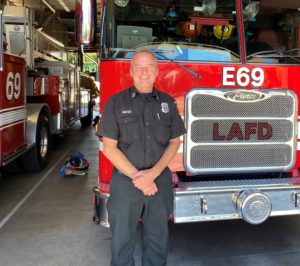 Although he has enjoyed the many places he has worked, this area holds a special place in his heart. “I love to surf, I love the ocean and it’s only a mile away,” he said. “It’s a blessing.”
Although he has enjoyed the many places he has worked, this area holds a special place in his heart. “I love to surf, I love the ocean and it’s only a mile away,” he said. “It’s a blessing.”
In 1992, Bates was called upon to help fight fires during the L.A. riots. The next year he was one of many firefighters assigned to the Malibu fires, and in 1994 he was on duty when the Northridge Earthquake struck.
On June 9, he had just finished a week of being sent to fires that were the results of the riots and looting, including on Melrose and in Santa Monica, Hollywood and Westwood.
After last year’s brush fires, Bates stresses: “It is important for residents to evacuate, when requested to, if a brush fire is threatening their neighborhood.”
He also reminds residents to test their smoke detectors monthly and to change the batteries annually.
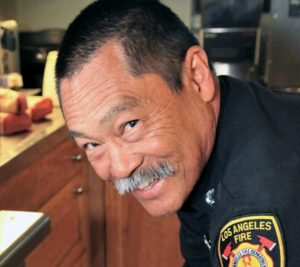 TOM KITAHATA has been with the LAFD for more than 32 years. He has worked in Hollywood, Echo Park/Rampart, South Central, Westlake, Van Nuys, East L.A. and Downtown L.A.
TOM KITAHATA has been with the LAFD for more than 32 years. He has worked in Hollywood, Echo Park/Rampart, South Central, Westlake, Van Nuys, East L.A. and Downtown L.A.
“Like many of my fellow firefighters at Fire Station 69 I have participated in the Northridge Earthquake, the Civil Disturbance of 1992, Calabasas and Malibu fires in the ’90s,” said Kitahata, who was also assigned to fight wildland fires in Northern California, the Sierras, and Los Padres, Cleveland and San Bernardino mountains.
Kitahata is also a member of FEMA’s California Task Force One Urban Search and Rescue Team. He was deployed to New York City after the World Trade Center attacks. Currently he is helping to run Covid-19 testing at one of many sites across the city.
“Whether it be brush fires in our wildland urban interface areas, earthquakes, floods or other disasters, residents need to have a plan for evacuation: what to take with you, where to go, and who to call,” Kitahata said. “Make a point to meet your neighbors and be friends. When the big one hits, you and your neighbors may be on your own until help arrives.”
C-Shift: Captains Paul Egizi and Erik Schneider:
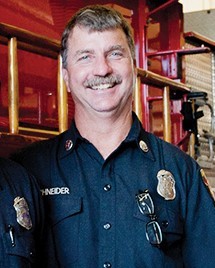 ERIK SCHNEIDER joined the force in 1986 and has spent most of that time in South Los Angeles and downtown L.A., before coming to Station 69 in August 2016.
ERIK SCHNEIDER joined the force in 1986 and has spent most of that time in South Los Angeles and downtown L.A., before coming to Station 69 in August 2016.
“The thing that surprises me most about the area is that the streets are so tight it really slows our response time,” Schneider said. He has also noticed how close residents are to brush interface. “If people live in an area that is close to the brush, they really need to be diligent about brush clearance.”
He has gone on several structure fires, but also was called to the Chimney Fire which burned 46,344 acres in San Luis Obispo County, and involved 3,985 personnel, including 328 fire engines, 106 hand crews, seven air tankers, 16 helicopters, 46 bulldozers and 69 water tenders.
PAUL EGIZI was disappointed about the July 4th cancellations in the Palisades.
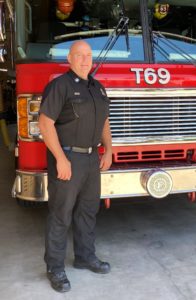 “We’re [the staff] bummed about it,” he said. “We always look forward to the parade.”
“We’re [the staff] bummed about it,” he said. “We always look forward to the parade.”
He joined Station 69 in January 2019, after working all over the city, starting as a paramedic in South L.A. in 1987. He later worked as an apparatus operator driving the hook-and-ladder in East L.A. During the 1992 riots he was working in mid-city.
Egizi made captain in 1998. For two years (2000-2002), he was in charge of the recruitment training academy, and from 2011 to 2013, he was the administrative captain in charge of air operations, overseeing seven helicopters.
“The relationship between the community and this fire station is unsurpassed in any of the 104 stations,” Egizi said. “The relationship here is really rewarding.”
He also happens to be the father of four adult daughters — all nurses.
His advice for residents? In an emergency call 911, rather than calling Station 69 directly or ringing the doorbell. “There’s a potential we’re not here, and time could go wasted trying to get us,” he said. “If 911 puts you on hold, you could do both, as a backup.”
Other members of FS 69 are: (A Shift) Todd Tsujimura, Steve Hazard, Tim Togneri, Ralph Hester, Danny Garcia, Marc Samama, Robert Trevino, Scott Christlieb, Daniel Ramirez and Charles Micalef; (B Shift) Greg Felix, Yvonne Gutierrez, Henry Gasbari, Jeff Escalante, Mike Thompson, Andy Carter, Salvador Castillon, Mark Glenchur, Joseph Kovacic and Robert Steinbacher; (C Shift) Dan Kleiser, Steve Shelp, Dennis Roach, Eric Dillon, Tim Van Dusen, Glenn Potter, Greg Cueto, Octavio Silveyra, Robert Miller and Mario Westphal.
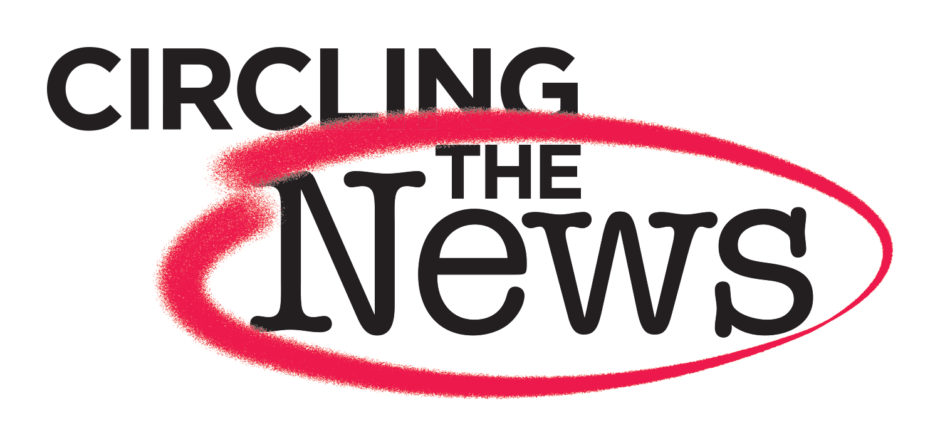
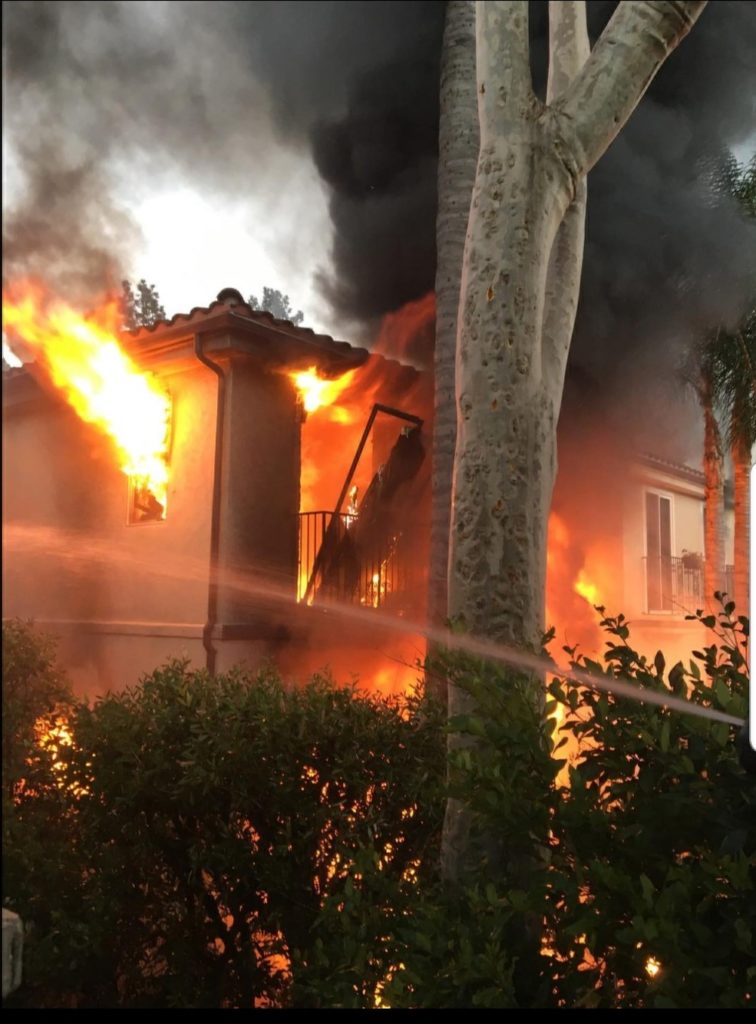

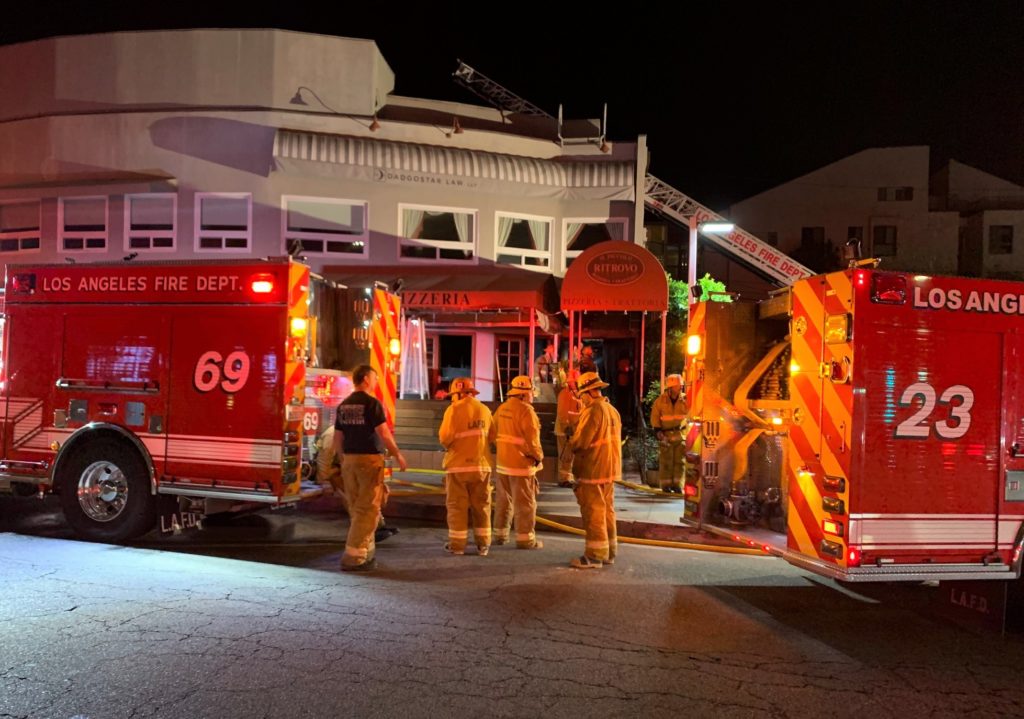
Hello Sue,
Can you please explain to your readers (like myself) how these different shifts work. I understand that the firefighters are on so many hours/days and then off so many hours/days, but I don’t know the shift schedules.
Any additional information would be helpful!
Thank you!!
Mike Sternfeld
Station 69 Captain Kitahata replied, “We work 24 hour shifts.
Our segment coming up is on June 18,20 and 22. We work 24 hours from 0630 to 0630. We are on for three shifts, then we are off for four.”